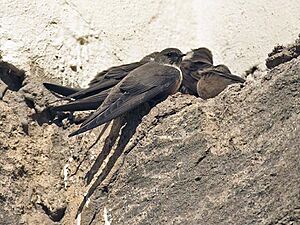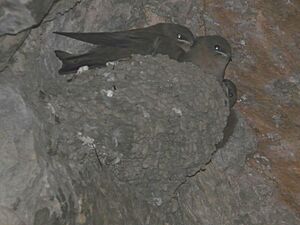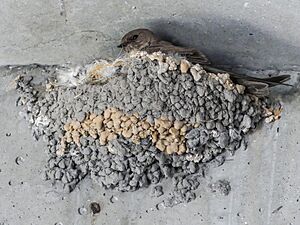Eurasian crag martin facts for kids
Quick facts for kids Eurasian crag martin |
|
|---|---|
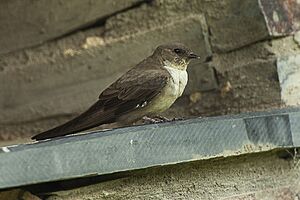 |
|
| Conservation status | |
| Scientific classification | |
| Genus: |
Ptyonoprogne
|
| Species: |
rupestris
|
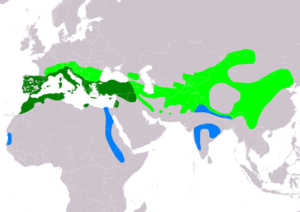 |
|
|
Breeding range
Resident year-round Non-breeding range |
|
| Synonyms | |
|
Hirundo rupestris |
|
The Eurasian crag martin (Ptyonoprogne rupestris) is a small bird from the swallow family. It's about 14 cm (5.5 in) long. This bird has ash-brown feathers on its back and lighter feathers underneath. Its short, square tail has special white patches on most feathers.
These birds live in the mountains of southern Europe, northwestern Africa, and across Asia. They can be confused with other crag martins, but they are larger. They also have brighter tail spots and slightly different feather colors. Many European crag martins stay in one place all year. However, some northern and Asian birds fly south for winter. They spend winter in northern Africa, the Middle East, or India.
The Eurasian crag martin builds its nest under cliff overhangs. It also builds nests on human-made buildings. The nest is a neat half-cup shape made of mud. It is lined with soft feathers and dry grass. Nests are often built alone, but a few pairs might nest close together. The female mainly sits on the two to five white eggs. Both parents feed the baby birds. This species does not form huge breeding groups. But they do gather in groups when it's not breeding season. They eat many different insects. They catch insects with their beaks while flying near cliffs or over streams. Bigger birds like hawks or corvids might hunt them. They can also get tiny blood-sucking mites. Luckily, there are many Eurasian crag martins, and their numbers are growing. So, they are not a species we need to worry about.
Contents
What is a Eurasian Crag Martin?
The Eurasian crag martin was first described in 1769. It was later moved into a new group called Ptyonoprogne in 1850. Its closest relatives are three other crag martins. These are the pale crag martin, the rock martin, and the dusky crag martin.
The name Ptyonoprogne comes from Greek words. Ptyon means "a fan," which describes the bird's tail when it's open. Procne is a name from an old story about a girl who turned into a swallow. The word rupestris means "of rocks" in Latin. This describes where the bird lives. There are no widely recognized types of this bird.
Crag martins are part of the swallow family. They are in a group called Hirundininae. This group includes all swallows and martins. Scientists have studied their DNA. They found that swallows can be grouped by how they build nests. There are "core martins" that dig burrows. There are "nest-adopters" that use natural holes. And there are "mud nest builders." Eurasian crag martins build open mud nests, so they are in the last group.
How to Identify a Crag Martin
The Eurasian crag martin is about 13–15 cm (5.1–5.9 in) long. Its wings spread about 32–34.5 cm (12.6–13.6 in) wide. It weighs about 23 grams (0.8 oz). Its back is ash-brown, and its belly is lighter. It has a wider body, wings, and tail than other European swallows.
Its tail is short and square. It has white patches near the tips of most tail feathers. The feathers under its wings and tail are dark. Its eyes are brown, and its small beak is mostly black. Its legs are brownish-pink. Male and female birds look alike. Young birds have buff-brown tips on their head and wing feathers.
You can tell this bird apart from the sand martin. The crag martin is bigger and has white tail patches. It also does not have a brown band across its chest. If you see it where other crag martins live, the Eurasian crag martin is darker and browner. It is also about 15% larger than the rock martin. Its white tail spots are much bigger than those of its relatives.
The crag martin's flight looks slow for a swallow. It flaps its wings quickly, then glides with flat wings. Its long, flexible wing feathers help it fly easily near cliffs. It often flies high, showing its white tail spots. Its calls sound like short, high pli, piieh, and tshir.
Where Crag Martins Live
Eurasian crag martins breed in mountains. They are found from Spain and northwest Africa across southern Europe. They also live in the Persian Gulf and the Himalayas. Their range extends to southwest and northeast China.
Birds from northern areas fly south for winter. European birds spend winter in north Africa, Senegal, Ethiopia, and the Nile Valley. Asian birds go to southern China, India, and the Middle East. Some European birds stay north of the Mediterranean Sea. Birds in warmer places like India and Turkey just move to lower areas after breeding.
Crag martins like to breed on dry, warm, and protected cliffs. These are often in mountains with rocky areas and deep valleys. They usually live at heights of 2,000–2,700 meters (6,600–8,900 ft). But they can breed as high as 5,000 meters (16,000 ft) in Central Asia.
The largest known winter home for Eurasian crag martins is in the Gorham's Cave Complex in Gibraltar. Up to 12,000 birds lived in these caves during the 2020-2021 winter. This is 1-2% of all European Eurasian crag martins!
Crag Martin Life Cycle
Nesting and Reproduction
Crag martin pairs nest alone or in small groups. These groups usually have fewer than ten nests. Nests are typically 30 meters (98 ft) apart. Each pair strongly protects its nesting area from other crag martins and most other birds.
Nesting happens from May to August. Usually, two sets of babies are raised each year. Both adult birds build the nest. It's an open half-cup made of mud. It's lined with soft things like feathers or dry grass. The nest is built under a rock overhang, in a crack, or on a human-made building. It takes one to three weeks to build. The birds use the same nest for their second brood and in later years.
A female lays two to five eggs, with three being the average. The eggs are white with brownish spots, especially on the wider end. They are about 20.2 x 14.0 mm (0.80 x 0.55 in) and weigh about 2.08 grams (0.07 oz). The female mainly sits on the eggs for 13–17 days until they hatch. The baby birds then take another 24–27 days to grow feathers and be ready to fly.
Both parents feed the chicks, bringing food every two to five minutes. The young birds are fed for 14–21 days after they leave the nest. Because they feed so often, the parents mostly hunt for food very close to the nest. This is because flying further would take too long to bring food back to the chicks.
In recent years, crag martins have started using houses and other human-made places to nest more often. This has given them more places to breed. It has helped the species spread to new areas.
What Crag Martins Eat
The Eurasian crag martin mainly eats insects. It catches them with its beak while flying. Sometimes, it will pick up food from rocks, the ground, or water. When breeding, birds often fly back and forth near a cliff. They hunt for insects both inside and outside their nesting area. At other times, they might hunt while flying over streams or mountain meadows.
The insects they eat depend on what is available. This can include flies, ants, spiders that fly, and beetles. Water insects like stoneflies and caddisflies seem important in places like Spain and Italy. Unlike other swallows, these birds feed close to their nests. This means they can be affected if there aren't enough insects nearby. When it's not breeding season, these martins gather in groups. They might form large flocks where there is a lot of food.
Cliffs create air currents that gather insects near vertical surfaces. The crag martin uses these areas to hunt. It is very good at flying and making sharp turns.
Winter Roosting Habits
Eurasian crag martins form large groups in winter. The biggest known winter roost is at the Gorham's Cave Complex in Gibraltar. A study there showed that birds are very loyal to certain caves. They often return to the same caves year after year. Birds caught at these caves had a more than 90% chance of being caught there again. The health of birds from different caves suggests that some roosting spots are better than others. This can affect how well the birds survive.
Dangers and Health Concerns
Sometimes, the peregrine falcon hunts this species. Falcons share the same mountain homes. When crag martins fly over the Himalayas, crows are also known to hunt them. Birds like kestrels, sparrowhawks, jays, and ravens are also seen as threats. Crag martins will dive at them repeatedly if they come near nesting cliffs. Even though crag martins are usually aggressive, they get along with house martins. This might be because the large numbers of house martins give an early warning about predators.
The crag martin can host blood-sucking mites. These include mites from the genus Dermanyssus. They can also have tiny mites in their noses. Scientists have found two new types of parasites on this martin. One is a fly called Ornithomya rupes from Gibraltar. The other is a flea called Ceratophyllus nanshanensis from China.
Crag Martin Status
The number of Eurasian crag martins in Europe is estimated to be between 360,000 and 1,110,000 birds. This includes 120,000–370,000 breeding pairs. A rough guess for the whole world is 500,000–5,000,000 birds. Europe has about one-quarter to one-half of all these birds.
The number of crag martins is thought to be growing. They are spreading further north. This might be because they are using more human-made buildings for nests. They have expanded their range in Austria, Switzerland, and other countries. Because they have a very large range and many birds, the Eurasian crag martin is not considered to be in danger. It is listed as "Least Concern" on the IUCN Red List.



